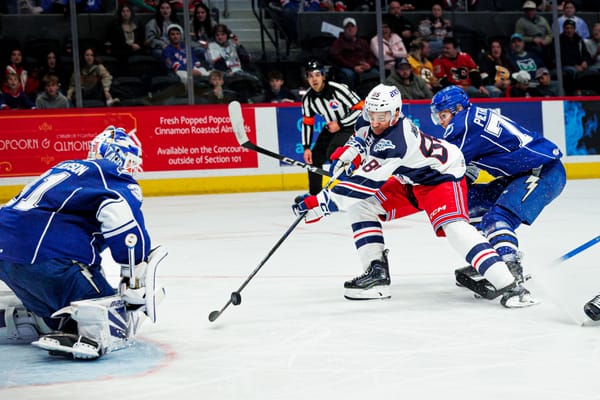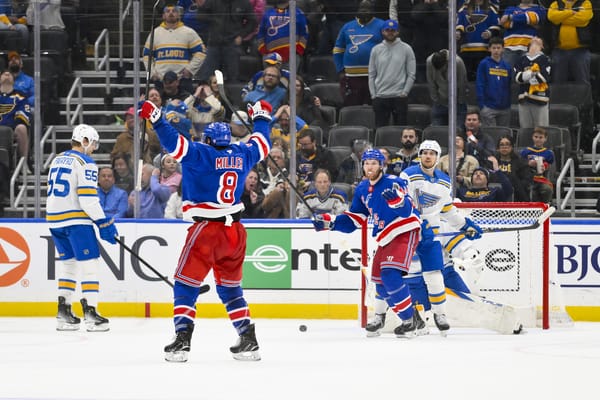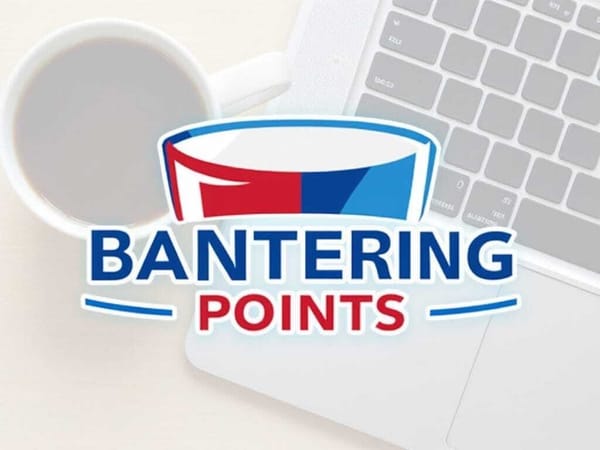Blueshirt Banter 2020 New York Rangers Prospect Rankings: 20-16
We break into the top-20.
20. Eric Ciccolini, Wing, University of Michigan, (NCAA)
2019 Ranking: 21
Age: 19
Acquired Via: 2019 Draft (Seventh Round)
Ciccolini was my sleeper prospect of the Rangers’ prospect pool last summer. I don’t think he did anything in his freshman season at Michigan to dispel that notion. From a bird’s-eye view, his stat line of one goal and ten assists in 26 games is nothing to get excited about. In context, though, its mundanity is easily understood.
First, his conversion rate of one goal on 28 shots is unlucky. He could have easily added a few more to that tally.
But the bigger issue for him was that Michigan’s roster in 2019-20 was flooded with wingers at the age of 21-22. His default position on the roster was as a fourth-line or even 13th forward, and given college hockey’s emphasis on seniority, that’s more or less where he stayed most of the season.
All things considered, I think that’s pretty decent production in his circumstances. It simply was not his season to break out and that was expected from the start.
This season will be better, although I think the situation is still unripe. He’s already earning middle-six minutes at Michigan but the presence of some remaining veterans, as well as one of the best freshman classes in college hockey history, has him still in a fairly supplementary role and an outsider on special teams. He so far has two goals in four games.
The Ontario native has a good wrist shot and a decent motor. Last season he showed a willingness to forecheck and battle for pucks but he often came out on the losing side because of a lack of strength. He’s improved in that area some, with room to still grow.
I think the best is yet to come for Ciccolini. He’ll likely be a four-year player at Michigan and it won’t be until he’s a junior that he’s really in a position to shine. My prediction for now is that he’ll earn an NHL contract in 2023 with the upside of a bottom-six NHL winger.
19. Tim Gettinger, Left Wing, Hartford Wolf Pack (AHL)
2019 Ranking: 16
Age: 22
Acquired Via: 2016 Draft (Fifth Round)
At the most basic level, Gettinger’s second professional season was better than his first. In Hartford, he produced the same number of points (27) and more goals (16) in 11 fewer games. That despite being buried on the depth chart at times through little fault of his own. Hartford’s lineup was stacked with wingers such as Vinni Lettieri, Phil di Giuseppe, and Vitali Kravtsov who commanded offensive minutes.
The second half of Gettinger’s season was much better as he saw increased opportunity. An extremely encouraging sign was his shot generation. He put at least two shots on goal in 12 of his last 15 games.
When Gettinger struggled in his four-game NHL debut two seasons ago, that was to be expected. He was a 20-year-old in his first professional season. His call-up was a surprise and he and the Rangers were playing with house money.
However, that he looked out of place in two games last season, despite earning his first NHL point, starts to raise a few questions. His skating, especially for his size, was adequate at worst at the junior and AHL level. The margins at the NHL level are so thin and I think that is at least one thing holding him back right now.
I don’t want to compare Tim Gettinger and Brian Boyle as players too much — the latter was a first-round pick — but Boyle went through an identity crisis that he didn’t really resolve until his mid-20s. He was a finesse player in high school and college but didn’t have enough skill to get by on it at the NHL level. He struggled massively until he realized he needed to accept what his role could be and adapt his game to become a physical, shutdown depth center.
I think Gettinger needs a similar transformation. His AHL production needs to improve, but broadly speaking I think he’s shown he’s a capable shooter and has some creativity. But his NHL upside is as a depth winger who forechecks and kills penalties. He’s not going to be getting many shots from the circles as he has in the OHL and AHL. I think if he can become a meaner player who can improve his abilities in the less glamorous parts of the game, he has a chance at making the NHL.
18. Oliver Tärnström, Center, AIK J20 (SuperElit)
2019 Ranking: N/A
Age: 18
Acquired Via: 2020 Draft (Third Round)
Following the Rangers’ drafting of Tärnström in October, I wrote that I had seen very little of him and mostly relied on reports from others (most notably that of Alex Nunn) to offer any analysis. Since then, I’ve managed to watch him in three or four SuperElit (Swedish Juniors) games this season. As such, I have new insights.
What stands out immediately about Tärnström is his hands. He’s a slick puckhandler who can weave through traffic, particularly in the middle of the ice, to avoid defenders and relieve pressure. He has a good shot with which he can deceive goaltenders from distance. He’s a creative passer. There’s no doubting his creativity on the puck and offensive capabilities.
The big issue is his skating. I’m not the person to offer nuanced insight into skating strides, but his straight-line speed is lacking, to say the least. He lacks a separation gear at the SuperElit level. His hands and vision get him by for now when it comes to carrying the puck in the neutral zone, but as he gets to higher levels he’ll need speed to beat better defenses. It’s also a hindrance to his ability to get up the ice on forechecks.
Furthermore, he turns with the proficiency of an 18-wheeler. Any attempt to change direction comes via wide, cumbersome, time-consuming loops. Again, this will become a major impediment at higher levels, and particularly so in North America where the action is quicker and the smaller ice surface is less forgiving of delayed pivots.
A smaller issue is that Tärnström is a string bean. Elite Prospects lists him at 6’1”, 163 pounds. His balance isn’t great and he’ll need to make a considerable effort to bulk up, though not at the further expense of his skating. Tärnström is in a quality hockey organization at AIK and the Rangers have an embarrassment of resources when it comes to nutrition and strength training, so as long as he’s committed this shouldn’t be a long-term problem.
The Rangers drafted him 30-45 picks sooner than I would have, but Tärnström’s NHL upside is obvious. He has enviable skills and offensive instincts and, if all goes well, it’s easy to imagine him as a third-line, maybe even middle-six, center. However, he’s so raw that Gordon Ramsay just had a heart attack. On the bright side, Tärnström turned 18 on August 30th, so he was just two weeks away from being eligible for the 2021 Draft. He has a longer runway than most, which is key because he’s going to need it. If the Rangers do eventually offer him an NHL contract, I imagine it will be following three, maybe four years in Sweden. He’s a major project and the Rangers are in this one for the long haul, but they’re hoping he’ll make the wait and growing pains worth it.
The J20 SuperElit was recently shut down temporarily due to COVID concerns. Tärnström was loaned to Hanvikens SK of the Swedish third-tier on November 18th in the meantime, although he has yet to feature in a game.
17. Hunter Skinner, Right Defense, London Knights (OHL)
2019 Ranking: 35
Age: 19
Acquired Via: 2019 Draft (Fourth Round)
While I stopped short of deeming him a non-prospect, I was very critical of the Rangers’ decision to draft Skinner in the fourth round in 2019. Then, in December, I offered a mea culpa for that take. At the time, Skinner had an absurd 22 points in 24 games.
I do believe I deserve partial credit for at least pointing out that Skinner’s numbers were inflated by his environment and puck luck. Over the remainder of the season, Skinner registered only three goals and seven assists in 38 games. Skinner was not as good offensively as his first half, nor is he as bad as his second half would indicate.
Skinner is raw, but his tools are intriguing. At 6’3’”, 190 pounds, he has the frame for a physical defender and he does play that way. His strength also manifests in a booming point shot, with which he generates the majority of his offense. I wouldn’t call his puck skills notable, but they’re adequate enough for the OHL to make a breakout pass or move the puck along the perimeter in the offensive zone. Most significantly, his skating is better than I initially gave him credit for. He’s not going to skate through a forecheck with the puck or kill a transition rush with a heroic backcheck from behind, but he has the requisite agility to get around the ice.
The COVID situation rears its ugly head yet again in these rankings, and I’m not sure it’s going to impact a Rangers’ prospect more than Skinner. Though 2019-20 was surely a net positive for Skinner, there were a lot of factors that shielded him from true scrutiny as well as opportunity. On one hand, I suspect that a loaded London Knights roster contributed to his point production. However, he was also behind older, fellow right-handed defensemen Ryan Merkley and Alec Regula on the depth chart.
This season was supposed to be enlightening. Skinner was slated to be London’s number-one defenseman. He would have played heavy minutes against the opposition’s top players and anchored the top power play unit. Sixty-eight regular season games plus a likely playoff run would have been the ultimate litmus test to indicate whether Skinner is a serious NHL prospect or not.
Instead, the OHL season is projected to be 40 games between February and April, and that’s optimistic at best. The COVID situation doesn’t appear the be getting better anytime soon and the league is currently fighting with Ontario politicians, whose stance currently is that hockey can’t resume unless body checking is temporarily removed.
A silver lining for the Rangers is that, because he was drafted from the USHL, Skinner’s rights don’t expire until 2021. He gets a year longer than the typical two-year signing deadline afforded to CHL prospects. If 2020-21 becomes a throwaway, they’ll at least have one more chance to evaluate him under (hopefully) normal conditions.
Skinner also has a very good chance to make the USA’s Word Juniors roster, which as of now is still scheduled to take place.
The Rangers took Skinner in the middle of the fourth round. A year later, I think they have a prospect who reflects his draft slot; no better but also no worse. He has upside as a depth NHL defenseman.
16. Tarmo Reunanen, Left Defense, HPK Hameenlinna (Liiga)
2019 Ranking: 15
Age: 22
Acquired Via: 2016 Draft (Fourth Round)
I’m always trying to figure out how to invoke the extremely knowledgeable and extremely British Alex Nunn in these rankings. Reunanen felt like the right player to bring him in for, as he’s not only seen the Finnish defensemen play far more than I have but also spoke to him in 2019.
Alex went into detail about Reunanen’s 2020-21 season. First, let’s set the scene. Last season, Reunanen logged nearly 20 minutes per game in a top-four role with Lukko in Finland’s top league. His point production was decent, with five goals and 14 assists in 51 games. More notable is that he was a strong possession driver. Reunanen was to begin his career in North America this season, but with COVID delaying the start he is currently on loan in Finland.
Now, to Alex.
“2016 fourth-round pick Tarmo Reunanen started the year with Mestis outfit TUTO in Finland’s second tier due to limitations that initially prevented him from signing a Liiga contract.
Reunanen soaked up minutes and posted nine points in seven games before quickly moving on to HPK under a short-term loan deal that affords him flexibility to move once the North American season begins
Since joining the Hämeenlinna club in early November, Reunanen has averaged a hair under 25 minutes per-night through seven starts, sliding straight onto their top defense pair alongside former TPS teammate Elmeri Eronen. Familiarity has certainly helped and the duo have handled much of HPK’s tough defensive assignments at even strength thus far.
Occasional hiccups with Reunanen’s play in his own end remain though consistent improvement to decision-making and positioning over the last 18 months are apparent. He’s not there yet but continues to trend in the right direction and show willingness to work on his weak areas.
Offensively Reunanen is as expected. He carries the puck confidently and looks to drive play, continues to shoot (~4.3 shot attempts per-game) and logs significant time on HPK’s man advantage. He’s rounding things out nicely and could yet be a dark horse for depth roster spots once training camp opens.”
Now it’s time for me to play my favorite role; Buzz Killington.
I think expectations for Reunanen are a bit over the top. I’ve seen some group him in with the Rangers’ top defensive prospects and I don’t think he’s anywhere close. Much has been made about the fact that he’ll be battling for an NHL spot in training camp. Yes, he will, but he’ll be very much on the outside looking in. Furthermore, the Rangers have one bona fide NHL lefty defenseman on the roster in Ryan Lindgren. On virtually any other team in the league he would be guaranteed to not only start the year in the AHL but spend the entire season there. That Reunanen has a chance says more about the current state of the Rangers’ defense than it does him.
I think there are a lot of questions about Reunanen’s NHL prospects. He has the requisite skating and puck skills to do his job on the breakout and make passes, but he’s not going to be a meaningful offensive contributor. If Reunanen is to have an NHL career it will have to be on shutdown merits. At 5’11”, he’s starting at a disadvantage. That hasn’t stopped plenty of otherwise capable NHL defenders, though, such as Adam Fox and Anton Strålman. Reunanen is a good skater who proved a more than adequate defender in Liiga. If he can close gaps and keep the puck out of danger then he has a shot as a third-pairing NHL defenseman.
If you’d like to catchup on the previous rankings in this series, you can do so here.




